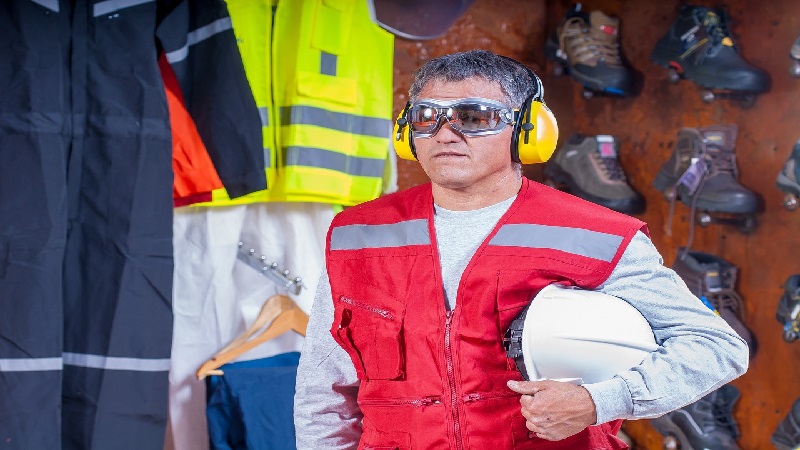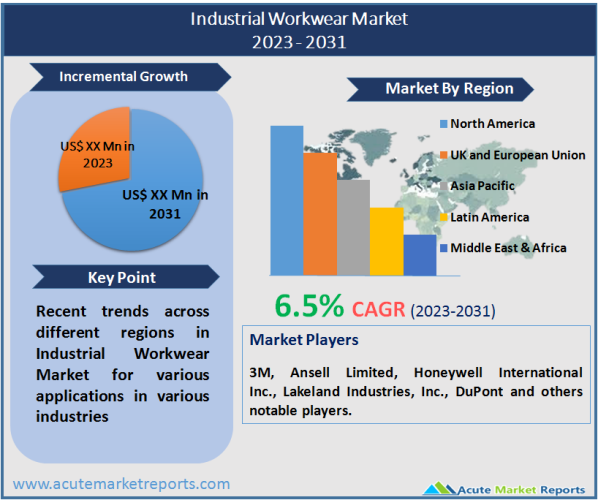
The global industrial workwear market is expected to grow at a CAGR of 6.5% during the forecast period of 2025 – 2033. The global industrial workwear market is a rapidly growing industry that provides specialized clothing and protective gear for workers in various industrial settings. The market is driven by the growing emphasis on workplace safety and the increasing number of workplace accidents. The demand for industrial workwear is also fuelled by the growing number of industrial activities across the globe. The global industrial workwear market is expected to continue its growth trajectory in the coming years. The market is segmented by product type, material type, end-use industry, and geography. The product types include disposable and durable workwear. The material types include aramid and blends, cotton and blends, and polyester and blends. The end-use industries include manufacturing, oil and gas, construction, and healthcare.

Growing Emphasis on Workplace Safety:
With the growing emphasis on workplace safety, there has been an increased demand for industrial workwear that can protect workers from various hazards such as chemical spills, fire, and electric shocks. According to a report by the International Labour Organization (ILO), over 2.78 million workers die each year due to work-related accidents and illnesses, with an additional 374 million workers suffering from non-fatal work-related injuries and illnesses. In the United States, the Bureau of Labor Statistics (BLS) reported that there were 2.8 million nonfatal workplace injuries and illnesses in the private sector in 2019 alone. The BLS also reported that the highest number of nonfatal workplace injuries and illnesses occurred in the manufacturing and healthcare industries, with the construction industry following closely behind. According to the National Safety Council (NSC), the total cost of work-related injuries and illnesses in the United States was $171 billion in 2019. The NSC also reported that the most common causes of workplace injuries and deaths were related to transportation, slips and falls, and contact with objects and equipment. The implementation of safety regulations and standards has been shown to have a positive impact on workplace safety. For example, the Occupational Safety and Health Act (OSHA) in the U.S. has been credited with reducing the number of workplace fatalities by over 60% since its implementation in 1970.
Growth in Industrial Activities:
The growth in industrial activities across the globe is expected to drive the demand for industrial workwear. The global industrial workwear market size is projected to grow at a CAGR of 5.6% from 2020 to 2025. This growth can be attributed to the increasing industrial activities in emerging economies such as China, India, and Brazil. In addition, the increasing investments in industrial infrastructure and the growth of the manufacturing sector are expected to drive the demand for industrial workwear in the coming years. According to a report by the United Nations Industrial Development Organization (UNIDO), global industrial production increased by 3.4% in 2018, with growth in emerging and developing economies outpacing that of developed economies. The increasing investments in industrial infrastructure, such as factories and production facilities, are expected to further drive the growth of industrial activities and the demand for industrial workwear. For example, China's Belt and Road Initiative, which aims to connect Asia with Europe and Africa through infrastructure investments, is expected to drive the demand for industrial workwear in the coming years.
High Cost of Industrial Workwear:
One of the major restraints for the industrial workwear market is the high cost of industrial workwear. The cost of industrial workwear is significantly higher than regular workwear due to the use of specialized materials and advanced manufacturing processes. This can be a challenge for small and medium-sized enterprises (SMEs) that have limited budgets for safety equipment. The high cost of industrial workwear is expected to hinder the growth of the global industrial protective clothing market during the forecast period. For instance, in the United States, the cost of protective clothing for workers can range from $30 to $150 per piece depending on the level of protection required. This can be a significant expense for companies that need to provide protective gear to a large number of workers. The high cost of industrial workwear is also a major concern in developing countries where there is a lack of awareness about workplace safety and limited budgets for safety equipment.
The Disposable Workwear is Expected to be the Fastest Growing Segment During the Forecast Period
The disposable workwear segment is expected to witness significant growth in the industrial workwear market due to its cost-effectiveness and convenience. This segment is projected to grow at a CAGR of 5.3% from 2025 to 2033. The durable workwear segment is also expected to witness growth, driven by the increasing demand for high-quality and durable workwear that can withstand harsh work conditions. One of the major drivers of the disposable workwear segment is the increasing emphasis on hygiene and cleanliness in various industries such as healthcare, food processing, and pharmaceuticals. Disposable workwear provides an effective barrier against bacteria, viruses, and other contaminants, reducing the risk of cross-contamination and the spread of infections.
Cotton and Blends Segment Are Dominating the Market by Material Type
The cotton and blends segment is expected to dominate the industrial workwear market due to the comfort and breathability of the cotton. This segment is projected to grow at a CAGR of 5.2% from 2025 to 2033. The aramid and blends segment is also expected to witness significant growth due to the high strength and heat-resistant properties of aramid. Cotton and blends are also popular materials used in industrial workwear. Cotton is a natural fiber widely used in the textile industry due to its durability, breathability, and softness. Cotton workwear is comfortable and allows for ease of movement, making it ideal for workers in various industries. Blends of cotton with synthetic fibers such as polyester and nylon are also popular due to their added strength, durability, and resistance to wrinkles and shrinking. In addition to being comfortable and durable, cotton and cotton blends are also considered to be environmentally friendly as they are biodegradable and can be recycled. The use of sustainable cotton and blends is becoming increasingly popular in the industrial workwear market as companies strive to reduce their environmental impact.
Manufacturing Industry Dominates Among the End Users
The manufacturing industry is expected to dominate the industrial workwear market due to the large workforce involved in manufacturing activities. This segment is projected to grow at a CAGR of 4.5% from 2025 to 2033. The manufacturing industry is a significant contributor to the global economy, and it is expected to continue its growth in the coming years. According to a report by the World Economic Forum, the global manufacturing industry is expected to grow by 3.4% annually from 2018 to 2025. The growth of the manufacturing industry is being driven by the increasing demand for manufactured products from various sectors such as automotive, aerospace, and electronics. The construction industry is also expected to witness significant growth due to the increasing construction activities across the globe.
North America Dominates in terms of Market Revenues
North America is one of the largest markets for industrial workwear due to the presence of several key players and a high emphasis on workplace safety regulations. The United States and Canada are the major markets in this region. The North American industrial protective clothing market is expected to grow at a CAGR of 10% from 2025 to 2033. Europe is another significant market for industrial workwear due to the high adoption of safety regulations and the presence of several large industries. The major markets in this region include the United Kingdom, Germany, France, Italy, and Spain. the Europe industrial workwear market is projected to grow at a CAGR of 4.5% from 2025 to 2033. Asia Pacific is expected to be the fastest-growing market for industrial workwear due to the increasing industrial activities in countries such as China, India, and Japan. The major markets in this region include China, India, Japan, South Korea, and Australia. The Asia Pacific industrial protective clothing market is expected to grow at the fastest pace. Latin America is also a significant market for industrial workwear due to the growth of the manufacturing sector in countries such as Brazil and Mexico. The Middle East and Africa region are expected to witness steady growth in the industrial workwear market due to the growth of the oil and gas industry and the increasing awareness about workplace safety. The major markets in this region include Saudi Arabia, the United Arab Emirates, South Africa, and Egypt.
Innovation Remains as the Key to Enhance Market Share
The industrial workwear market is highly competitive, with the presence of both multinational and regional players. Some of the major players in the market include 3M, Ansell Limited, Honeywell International Inc., Lakeland Industries, Inc., DuPont, and other notable players. These companies are investing in research and development activities to develop innovative and high-quality products to gain a competitive edge in the market. Additionally, strategic partnerships and collaborations with end-users and distributors are also common strategies adopted by companies to expand their market presence.
Historical & Forecast Period
This study report represents analysis of each segment from 2023 to 2033 considering 2024 as the base year. Compounded Annual Growth Rate (CAGR) for each of the respective segments estimated for the forecast period of 2025 to 2033.
The current report comprises of quantitative market estimations for each micro market for every geographical region and qualitative market analysis such as micro and macro environment analysis, market trends, competitive intelligence, segment analysis, porters five force model, top winning strategies, top investment markets, emerging trends and technological analysis, case studies, strategic conclusions and recommendations and other key market insights.
Research Methodology
The complete research study was conducted in three phases, namely: secondary research, primary research, and expert panel review. key data point that enables the estimation of Industrial Workwear market are as follows:
Market forecast was performed through proprietary software that analyzes various qualitative and quantitative factors. Growth rate and CAGR were estimated through intensive secondary and primary research. Data triangulation across various data points provides accuracy across various analyzed market segments in the report. Application of both top down and bottom-up approach for validation of market estimation assures logical, methodical and mathematical consistency of the quantitative data.
| ATTRIBUTE | DETAILS |
|---|---|
| Research Period | 2023-2033 |
| Base Year | 2024 |
| Forecast Period | 2025-2033 |
| Historical Year | 2023 |
| Unit | USD Million |
| Segmentation | |
Type
| |
Application
| |
End-use
| |
Fit Type
| |
Pricing
| |
Distribution Channel
| |
|
Region Segment (2023-2033; US$ Million)
|
Key questions answered in this report